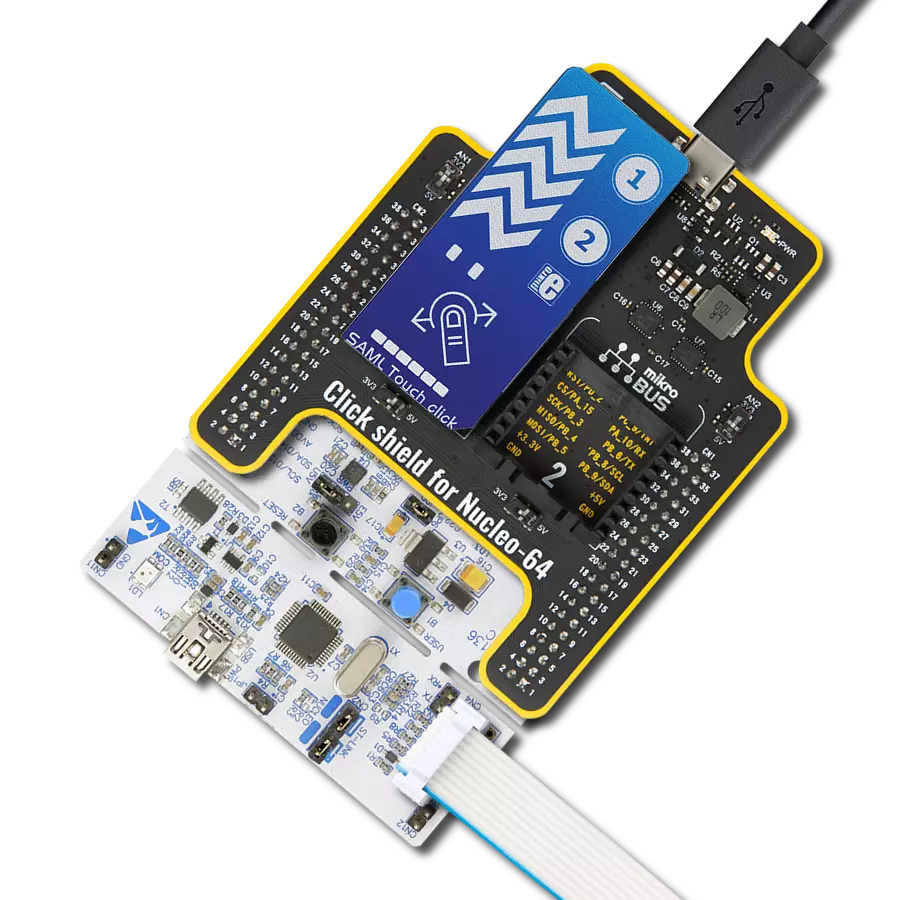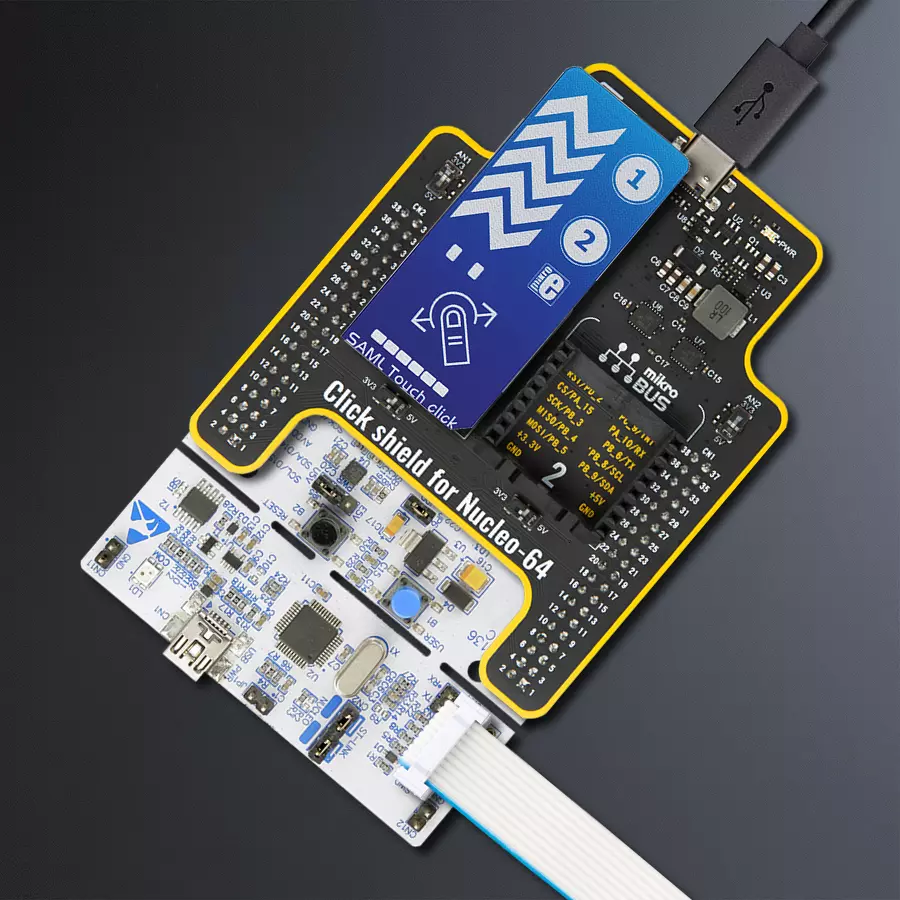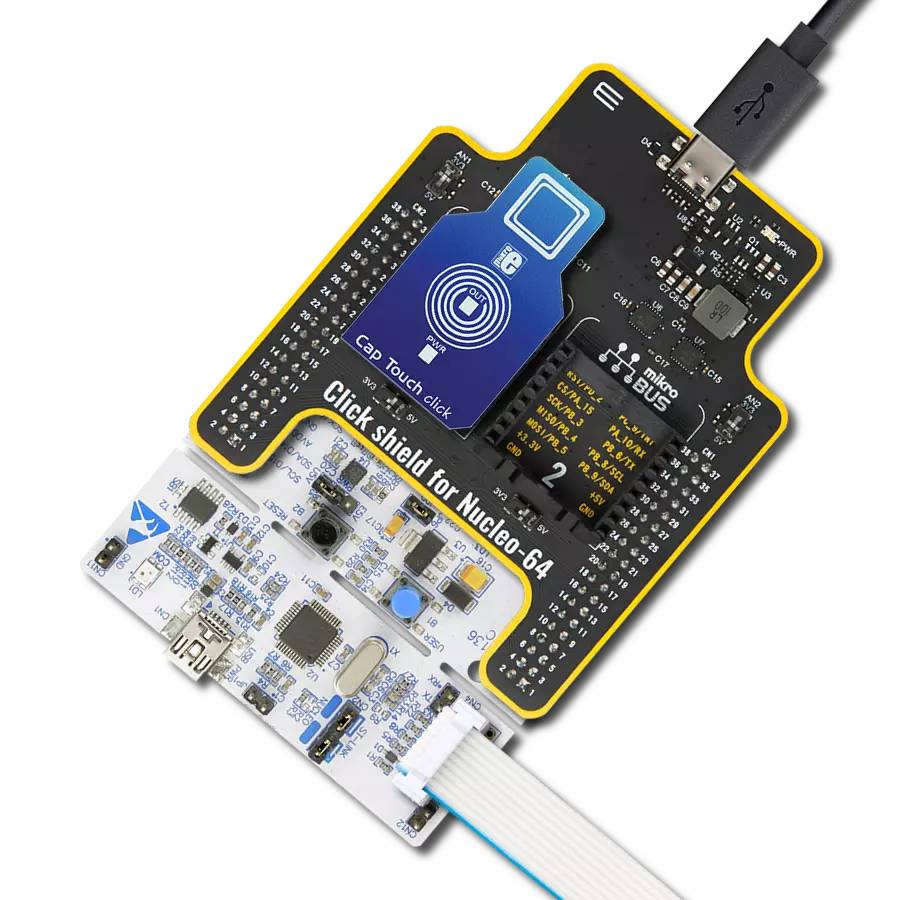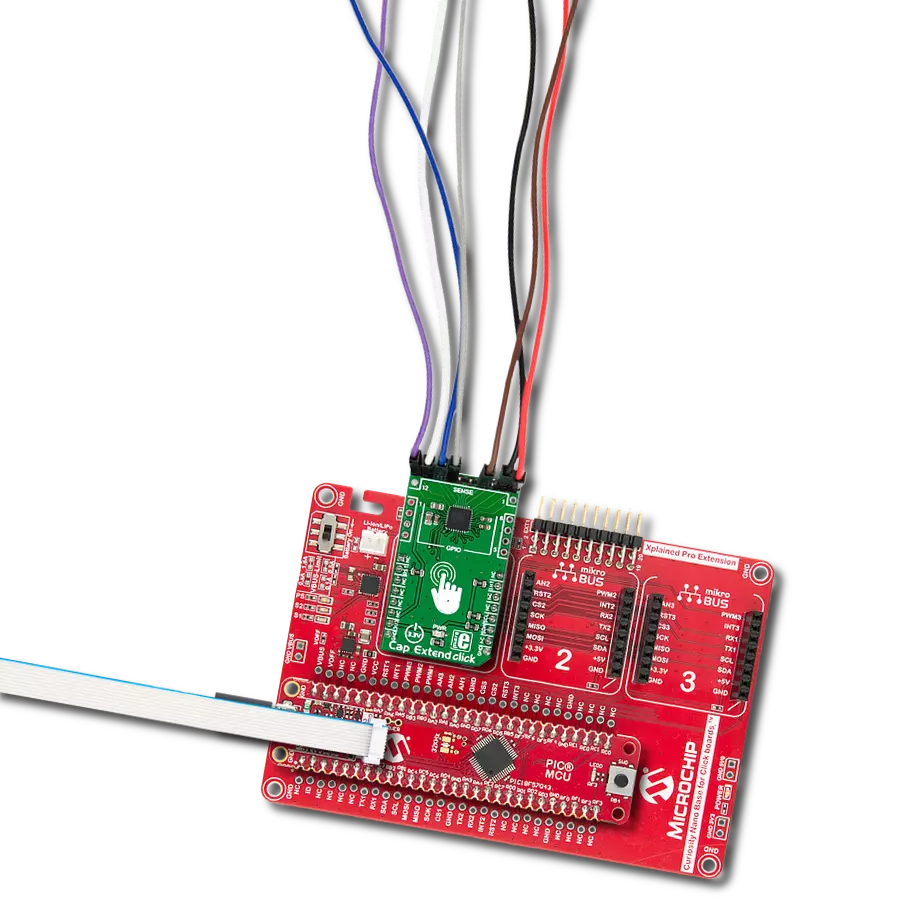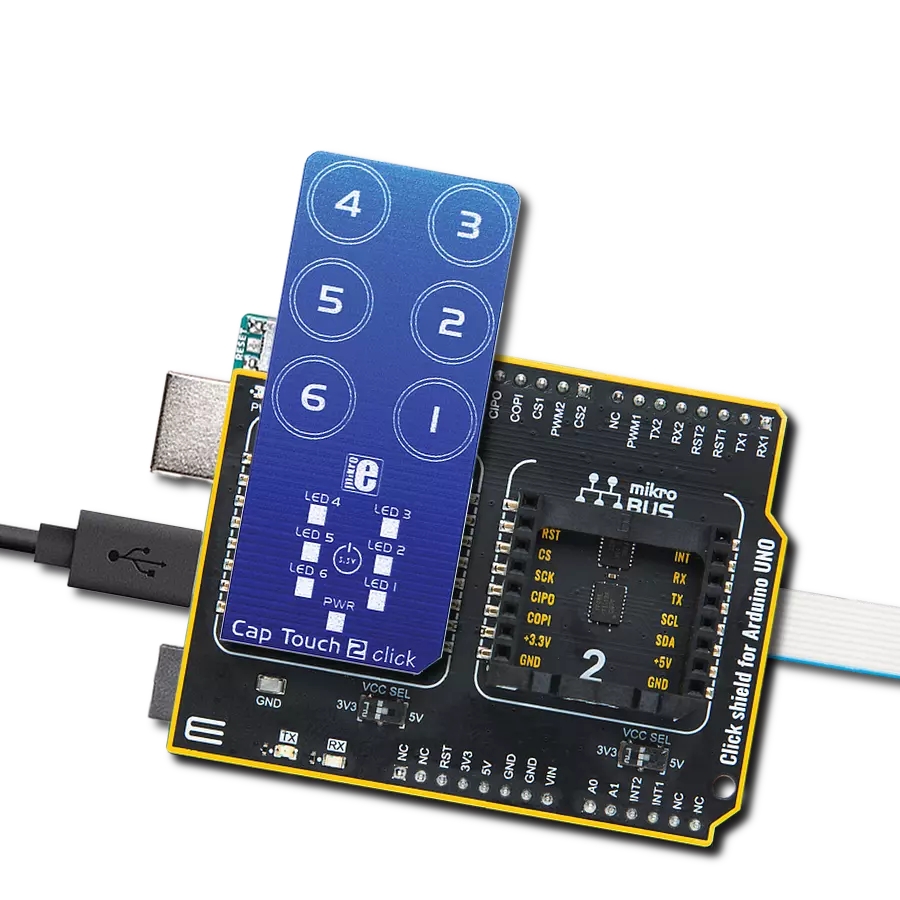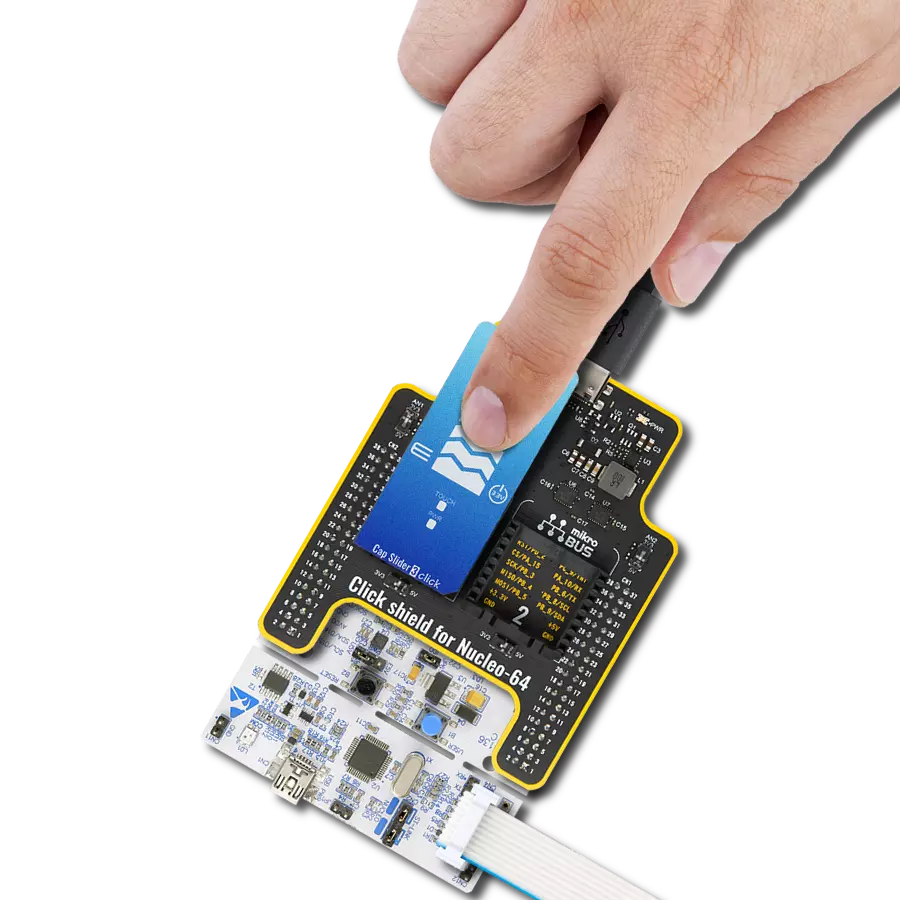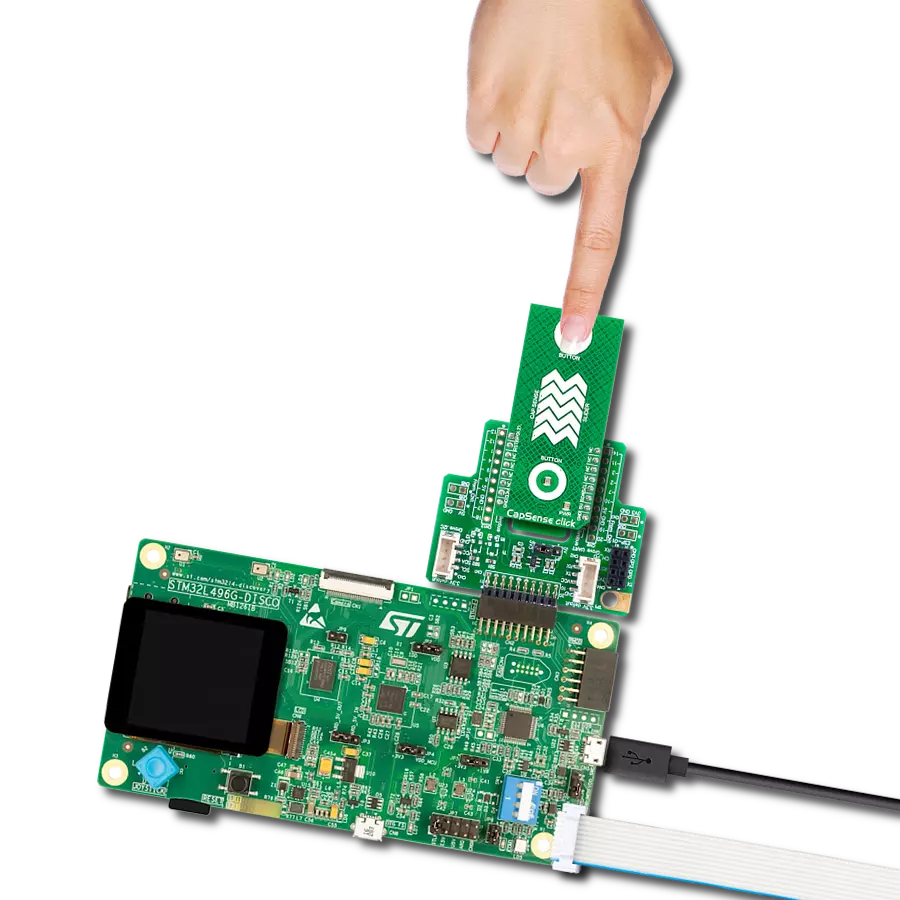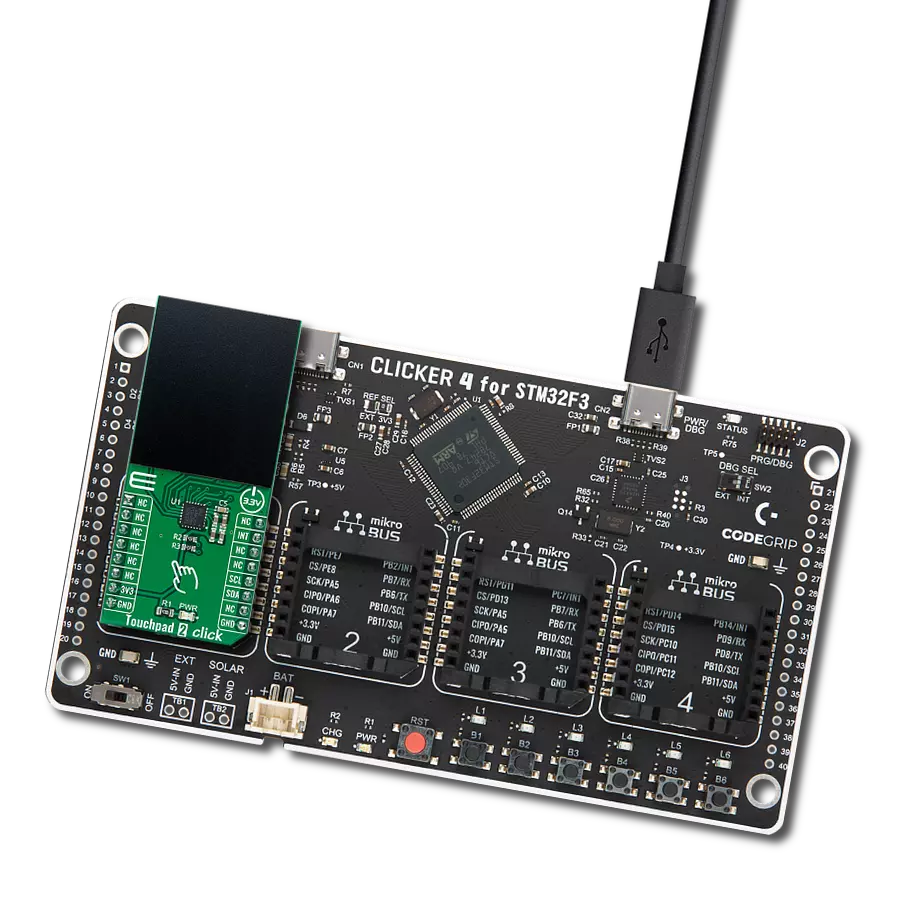Designed to empower user creativity and productivity, the purpose of our solution lies in its ability to offer multiple touch points and a slider for seamless, gesture-based control, enhancing the overall user experience
A
A
Hardware Overview
How does it work?
SAML Touch Click is based on the ATSAML10, an ultra-low power 32-bit ARM® Cortex® MicroController Unit (MCU) from Microchip. Among many other features, this MCU contains the enhanced Peripheral Touch Controller (PTC) module, making it a perfect solution for various capacitive touch-based applications that require superior noise immunity. One of the key features of the PTC module is its ability to sense touch events reliably, even when covered with water. SAML click demonstrates the overall hardware simplicity of one such application: capacitive pads are directly connected to the MCU pins, with no additional components required. Everything is already integrated within the PTC module of the ATSAML10 MCU itself, allowing fast development. The only passive components on this click are the resistors that limit the current through the LEDs, and accompanying filtering capacitors.
As mentioned, the enhanced PTC module provides many benefits over similar solutions. The most distinctive is its parallel acquisition capability, allowing it to process all the inputs in parallel and simultaneously detect multiple touch events. This increases the responsiveness of the touch interface compared to traditional sequential acquisition circuits. It also improves noise immunity and robustness when used in harsh and humid environments. This allows the Click board™ to use an acrylic overlay and still accurately detect touch events. Another feature of the enhanced PTC module is the Driven Shield Plus capability. This capability adds another layer of noise protection to the application. It allows touch sensors to work while exposed to moisture, sweat, rain, and even running water. Any capacitive touch channel can be used as a driven shield channel, offering IP-68-compliant protection.
A cleverly designed firmware is responsible for event detection, visual feedback over LED indicators, and communication with the host MCU. The MCU firmware is written using Q-Touch® libraries from Microchip, which offer full support for PTC modules. The communication with the ATSAML10 is realized over the UART interface. A set of UART command strings are available for touch detection and the touch slider position. However, the Click board™ is supported by a mikroSDK compatible library, offering simple functions, saving the developer to write UART command parsers. These functions allow faster development and simplified software design. The Click board™ is designed to work with 3.3V only. If interfacing with systems that use 5V for their operation, an appropriate level of translating circuitry has to be used.
Features overview
Development board
Nucleo-64 with STM32F091RC MCU offers a cost-effective and adaptable platform for developers to explore new ideas and prototype their designs. This board harnesses the versatility of the STM32 microcontroller, enabling users to select the optimal balance of performance and power consumption for their projects. It accommodates the STM32 microcontroller in the LQFP64 package and includes essential components such as a user LED, which doubles as an ARDUINO® signal, alongside user and reset push-buttons, and a 32.768kHz crystal oscillator for precise timing operations. Designed with expansion and flexibility in mind, the Nucleo-64 board features an ARDUINO® Uno V3 expansion connector and ST morpho extension pin
headers, granting complete access to the STM32's I/Os for comprehensive project integration. Power supply options are adaptable, supporting ST-LINK USB VBUS or external power sources, ensuring adaptability in various development environments. The board also has an on-board ST-LINK debugger/programmer with USB re-enumeration capability, simplifying the programming and debugging process. Moreover, the board is designed to simplify advanced development with its external SMPS for efficient Vcore logic supply, support for USB Device full speed or USB SNK/UFP full speed, and built-in cryptographic features, enhancing both the power efficiency and security of projects. Additional connectivity is
provided through dedicated connectors for external SMPS experimentation, a USB connector for the ST-LINK, and a MIPI® debug connector, expanding the possibilities for hardware interfacing and experimentation. Developers will find extensive support through comprehensive free software libraries and examples, courtesy of the STM32Cube MCU Package. This, combined with compatibility with a wide array of Integrated Development Environments (IDEs), including IAR Embedded Workbench®, MDK-ARM, and STM32CubeIDE, ensures a smooth and efficient development experience, allowing users to fully leverage the capabilities of the Nucleo-64 board in their projects.
Microcontroller Overview
MCU Card / MCU
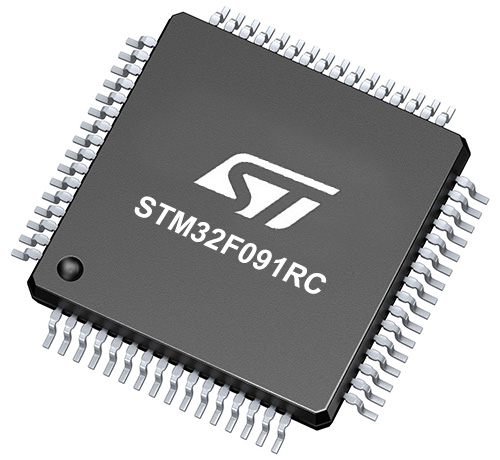
Architecture
ARM Cortex-M0
MCU Memory (KB)
256
Silicon Vendor
STMicroelectronics
Pin count
64
RAM (Bytes)
32768
You complete me!
Accessories
Click Shield for Nucleo-64 comes equipped with two proprietary mikroBUS™ sockets, allowing all the Click board™ devices to be interfaced with the STM32 Nucleo-64 board with no effort. This way, Mikroe allows its users to add any functionality from our ever-growing range of Click boards™, such as WiFi, GSM, GPS, Bluetooth, ZigBee, environmental sensors, LEDs, speech recognition, motor control, movement sensors, and many more. More than 1537 Click boards™, which can be stacked and integrated, are at your disposal. The STM32 Nucleo-64 boards are based on the microcontrollers in 64-pin packages, a 32-bit MCU with an ARM Cortex M4 processor operating at 84MHz, 512Kb Flash, and 96KB SRAM, divided into two regions where the top section represents the ST-Link/V2 debugger and programmer while the bottom section of the board is an actual development board. These boards are controlled and powered conveniently through a USB connection to program and efficiently debug the Nucleo-64 board out of the box, with an additional USB cable connected to the USB mini port on the board. Most of the STM32 microcontroller pins are brought to the IO pins on the left and right edge of the board, which are then connected to two existing mikroBUS™ sockets. This Click Shield also has several switches that perform functions such as selecting the logic levels of analog signals on mikroBUS™ sockets and selecting logic voltage levels of the mikroBUS™ sockets themselves. Besides, the user is offered the possibility of using any Click board™ with the help of existing bidirectional level-shifting voltage translators, regardless of whether the Click board™ operates at a 3.3V or 5V logic voltage level. Once you connect the STM32 Nucleo-64 board with our Click Shield for Nucleo-64, you can access hundreds of Click boards™, working with 3.3V or 5V logic voltage levels.
Used MCU Pins
mikroBUS™ mapper
Take a closer look
Click board™ Schematic

Step by step
Project assembly
Track your results in real time
Application Output
1. Application Output - In Debug mode, the 'Application Output' window enables real-time data monitoring, offering direct insight into execution results. Ensure proper data display by configuring the environment correctly using the provided tutorial.

2. UART Terminal - Use the UART Terminal to monitor data transmission via a USB to UART converter, allowing direct communication between the Click board™ and your development system. Configure the baud rate and other serial settings according to your project's requirements to ensure proper functionality. For step-by-step setup instructions, refer to the provided tutorial.

3. Plot Output - The Plot feature offers a powerful way to visualize real-time sensor data, enabling trend analysis, debugging, and comparison of multiple data points. To set it up correctly, follow the provided tutorial, which includes a step-by-step example of using the Plot feature to display Click board™ readings. To use the Plot feature in your code, use the function: plot(*insert_graph_name*, variable_name);. This is a general format, and it is up to the user to replace 'insert_graph_name' with the actual graph name and 'variable_name' with the parameter to be displayed.

Software Support
Library Description
This library contains API for SAML Touch Click driver.
Key functions:
samltouch_generic_write- Generic write functionsamltouch_generic_read- Generic read functionsamltouch_parser- Generic parser function
Open Source
Code example
The complete application code and a ready-to-use project are available through the NECTO Studio Package Manager for direct installation in the NECTO Studio. The application code can also be found on the MIKROE GitHub account.
/*!
* \file
* \brief SamlTouch Click example
*
* # Description
* This example reads and processes data from SAML Touch Clicks.
*
* The demo application is composed of two sections :
*
* ## Application Init
* Initializes driver.
*
* ## Application Task
* Reads the received data and parses it.
*
* ## Additional Function
* - samltouch_process ( ) - The general process of collecting data the module sends.
*
* \author MikroE Team
*
*/
// ------------------------------------------------------------------- INCLUDES
#include "board.h"
#include "log.h"
#include "samltouch.h"
#include "string.h"
#define PROCESS_RX_BUFFER_SIZE 1000
#define PROCESS_BUFFER_SIZE 80
// ------------------------------------------------------------------ VARIABLES
static samltouch_t samltouch;
static log_t logger;
samltouch_state_t saml_touch_status;
static char uart_rx_buffer[ PROCESS_RX_BUFFER_SIZE ] = { 0 };
static char current_parser_buffer[ PROCESS_BUFFER_SIZE ];
static uint8_t flag_1 = 0;
static uint8_t flag_2 = 0;
static uint16_t wait_cnt = 0;
static uint16_t button1_cnt = 0;
static uint16_t button2_cnt = 0;
// ------------------------------------------------------- ADDITIONAL FUNCTIONS
static void samltouch_process ( void )
{
int32_t rsp_size;
uint16_t check_buf_cnt;
// Clear RX buffer
memset( uart_rx_buffer, 0, PROCESS_RX_BUFFER_SIZE );
// Clear Parser buffer
memset( current_parser_buffer, 0, PROCESS_BUFFER_SIZE );
rsp_size = samltouch_generic_read( &samltouch, uart_rx_buffer, PROCESS_RX_BUFFER_SIZE );
if ( rsp_size > 0 )
{
for ( check_buf_cnt = 0; check_buf_cnt < rsp_size; check_buf_cnt++ ) {
if ( uart_rx_buffer[check_buf_cnt] == SAMLTOUCH_START_FRAME && ( (check_buf_cnt + 76) <= rsp_size ) ) {
memcpy( current_parser_buffer, &uart_rx_buffer[check_buf_cnt], 76 );
if ( current_parser_buffer[ 10 ] == 1 )
{
button1_cnt++;
}
if ( current_parser_buffer[ 20 ] == 1 )
{
button2_cnt++;
}
flag_1 = 1;
break;
}
}
}
}
void parser_application ( )
{
samltouch_process( );
if ( flag_1 == 1 )
{
samltouch_parser( current_parser_buffer, &saml_touch_status );
flag_2 = 0;
if ( saml_touch_status.button2 == 1 && button2_cnt > 2 )
{
log_printf( &logger, "\r\n Button 2 is pressed. \r\n" );
flag_2 = 1;
wait_cnt = 0;
button2_cnt = 2;
}
if ( saml_touch_status.button1 == 1 && button1_cnt > 2 )
{
log_printf( &logger, "\r\n Button 1 is pressed. \r\n" );
flag_2 = 1;
wait_cnt = 0;
button1_cnt = 2;
}
if ( saml_touch_status.sw_state == 1 && saml_touch_status.sw_pos != 0 )
{
log_printf( &logger, "\r\n Slider position is %u \r\n", (uint16_t) saml_touch_status.sw_pos );
flag_2 = 1;
wait_cnt = 0;
}
flag_1 = 0;
}
if ( flag_2 == 1 )
{
Delay_100ms( );
}
else
{
if ( wait_cnt++%50 == 0 )
{
log_printf( &logger, "\r\n Waiting for an event: \r\n" );
button1_cnt = 0;
button2_cnt = 0;
}
log_printf( &logger, "." );
Delay_100ms( );
}
}
// ------------------------------------------------------ APPLICATION FUNCTIONS
void application_init ( void )
{
log_cfg_t log_cfg;
samltouch_cfg_t cfg;
/**
* Logger initialization.
* Default baud rate: 115200
* Default log level: LOG_LEVEL_DEBUG
* @note If USB_UART_RX and USB_UART_TX
* are defined as HAL_PIN_NC, you will
* need to define them manually for log to work.
* See @b LOG_MAP_USB_UART macro definition for detailed explanation.
*/
LOG_MAP_USB_UART( log_cfg );
log_init( &logger, &log_cfg );
log_info( &logger, "---- Application Init ----" );
// Click initialization.
samltouch_cfg_setup( &cfg );
SAMLTOUCH_MAP_MIKROBUS( cfg, MIKROBUS_1 );
samltouch_init( &samltouch, &cfg );
Delay_ms ( 500 );
}
void application_task ( void )
{
parser_application( );
}
int main ( void )
{
/* Do not remove this line or clock might not be set correctly. */
#ifdef PREINIT_SUPPORTED
preinit();
#endif
application_init( );
for ( ; ; )
{
application_task( );
}
return 0;
}
// ------------------------------------------------------------------------ END
Additional Support
Resources
Category:Capacitive
